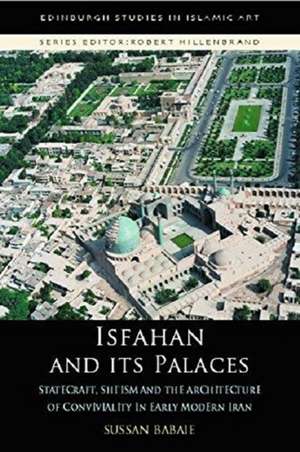Isfahan and Its Palaces: Edinburgh Studies in Islamic Art
Autor Sussan Babaieen Limba Engleză Paperback – 5 apr 2018
Din seria Edinburgh Studies in Islamic Art
- 17%
 Preț: 681.65 lei
Preț: 681.65 lei - 17%
 Preț: 677.38 lei
Preț: 677.38 lei - 17%
 Preț: 682.36 lei
Preț: 682.36 lei - 17%
 Preț: 653.99 lei
Preț: 653.99 lei - 5%
 Preț: 293.25 lei
Preț: 293.25 lei - 5%
 Preț: 296.09 lei
Preț: 296.09 lei - 5%
 Preț: 294.66 lei
Preț: 294.66 lei - 17%
 Preț: 681.27 lei
Preț: 681.27 lei - 22%
 Preț: 295.16 lei
Preț: 295.16 lei - 5%
 Preț: 293.25 lei
Preț: 293.25 lei - 23%
 Preț: 814.11 lei
Preț: 814.11 lei - 17%
 Preț: 682.43 lei
Preț: 682.43 lei - 5%
 Preț: 244.70 lei
Preț: 244.70 lei - 17%
 Preț: 651.97 lei
Preț: 651.97 lei - 17%
 Preț: 716.18 lei
Preț: 716.18 lei - 18%
 Preț: 772.46 lei
Preț: 772.46 lei - 17%
 Preț: 769.77 lei
Preț: 769.77 lei - 14%
 Preț: 1072.17 lei
Preț: 1072.17 lei
Preț: 295.05 lei
Preț vechi: 309.50 lei
-5% Nou
Puncte Express: 443
Preț estimativ în valută:
56.46€ • 61.31$ • 47.43£
56.46€ • 61.31$ • 47.43£
Carte indisponibilă temporar
Doresc să fiu notificat când acest titlu va fi disponibil:
Se trimite...
Preluare comenzi: 021 569.72.76
Specificații
ISBN-13: 9781474437196
ISBN-10: 1474437192
Pagini: 344
Ilustrații: 60 B/W illustrations 24 colour illustrations 24 colour and 60 b+w illustrations
Dimensiuni: 175 x 244 x 22 mm
Greutate: 0.86 kg
Editura: EDINBURGH UNIVERSITY PRESS
Seria Edinburgh Studies in Islamic Art
ISBN-10: 1474437192
Pagini: 344
Ilustrații: 60 B/W illustrations 24 colour illustrations 24 colour and 60 b+w illustrations
Dimensiuni: 175 x 244 x 22 mm
Greutate: 0.86 kg
Editura: EDINBURGH UNIVERSITY PRESS
Seria Edinburgh Studies in Islamic Art
Cuprins
1. Introduction: Conviviality, Charismatic Absolutism, and the Persianizing of Shi'ism
2. Peripatetic Kings and Palaces: From Tabriz to Qazvin in the Sixteenth Century
3. Dwelling in Paradise, or Isfahan "Half the World"
4. Architectural (Re)Persianization of Muslim Kingship: The Daulatkhane (The Abode of Felicity) Royal Precinct
5. Inventing the Spatial Choreography of Feasting: the Talar Palaces of Isfahan
6. Feasting and the Perso-Shi'i Etiquette of Kingship
7. Safavid Dynastic Chart
8. A Buildings' Chart
Bibliography
2. Peripatetic Kings and Palaces: From Tabriz to Qazvin in the Sixteenth Century
3. Dwelling in Paradise, or Isfahan "Half the World"
4. Architectural (Re)Persianization of Muslim Kingship: The Daulatkhane (The Abode of Felicity) Royal Precinct
5. Inventing the Spatial Choreography of Feasting: the Talar Palaces of Isfahan
6. Feasting and the Perso-Shi'i Etiquette of Kingship
7. Safavid Dynastic Chart
8. A Buildings' Chart
Bibliography
Notă biografică
Sussan Babaie is currently teaching at The Courtauld Institute of Art in London, where her research focuses on imperialism and artistic patronage in Persianate West, Central and South Asia where high culture derived from the literary corpus of the Persian language. She has previously taught in the Department of the History of Art at the University of Michigan, Smith College, and New York University. Sussan is co-author of Slaves of the Shah: New Elites of Safavid Iran (2004) and Persian Drawings in the Metropolitan Museum of Art (1989).
Descriere
This beautifully illustrated history of Safavid Isfahan (1501 1722) explores the architectural and urban forms and networks of socio-cultural action that reflected a distinctly early-modern and Perso-Shi'i practice of kingship.
